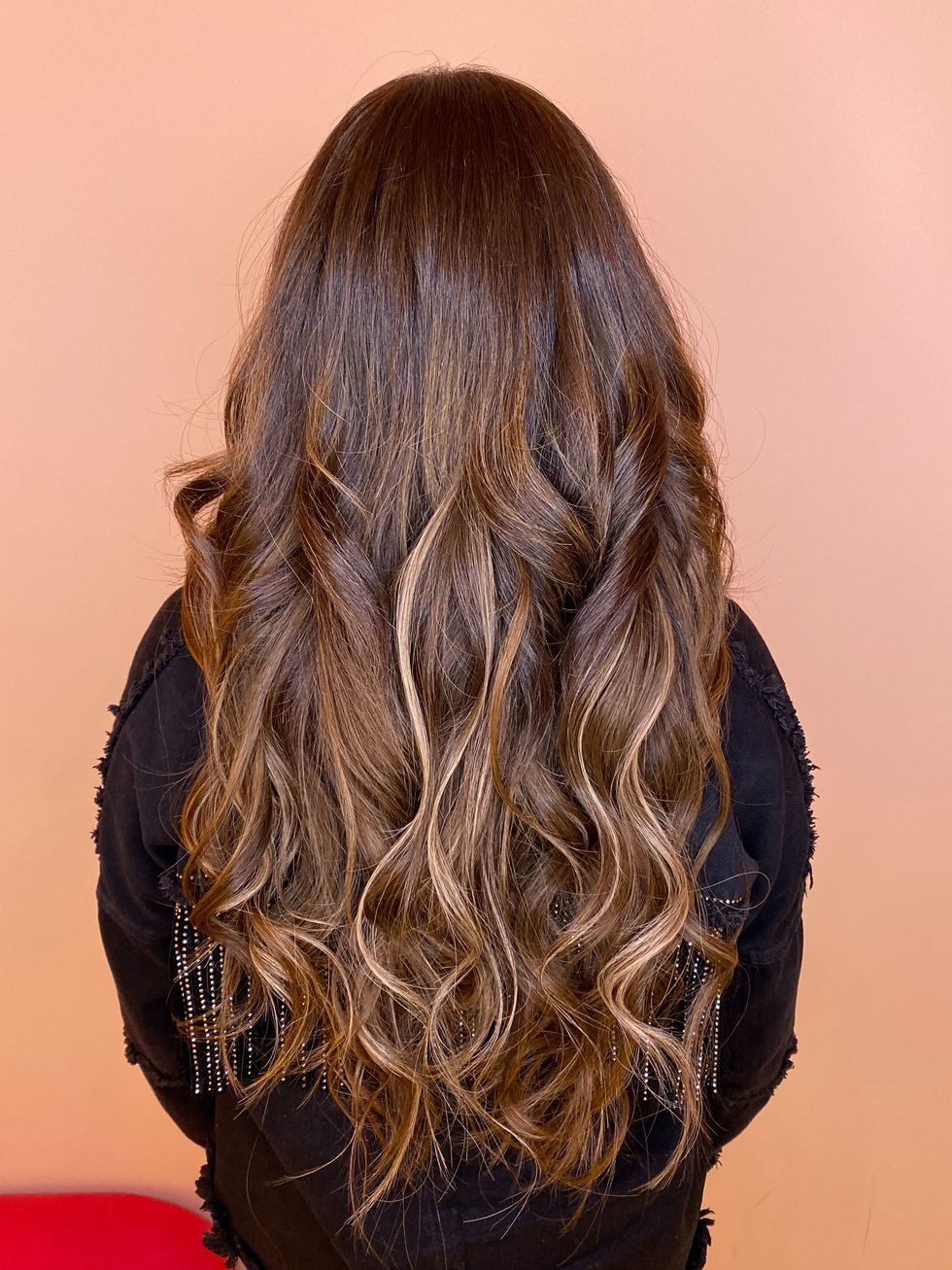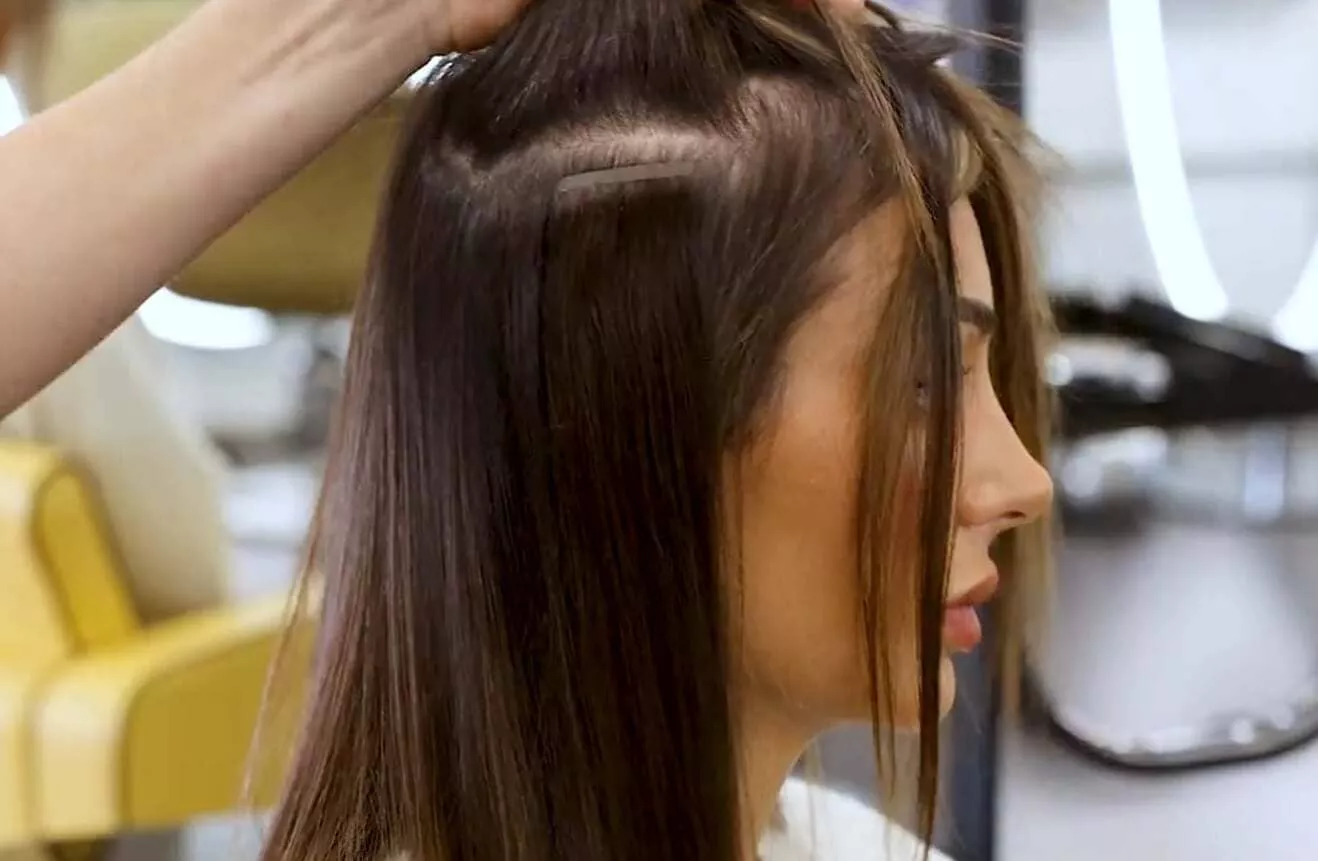Are you tired of your thin hair or want to add some length and volume to your natural strands? Look no further than tape-in hair extensions! These permanent extensions have gained popularity in the beauty industry for their easy application, natural look, and versatility. Whether you want to create a sleek ponytail, add wide wefts for more coverage, or have a hairstylist braid them into your hair, tape-in extensions can do it all!
Tape-in hair extensions use small tapes or tape tabs that are applied to the roots of your natural hair with glue by a hairstylist. The tapes are then secured with a special tool that heats them up and fuses them together, allowing for easy styling of braid and ponytail with any of your favorite tools. The result is a seamless blend between the extension and your natural hair.
Whether you’re looking for a ponytail or want to braid your hair, tape-in hair extensions made from natural strands offer a wide range of possibilities for all hair types. They come in various lengths, textures, and colors that can be styled by a hairstylist. To maintain their quality, use a shampoo specifically designed for extensions and avoid using heated styling tools excessively. With tape-in hair extensions, you can choose the perfect match for you.
If you’re considering getting tape-in hair extensions, it’s important to consult with a hairstylist and weigh the pros and cons before making a decision. These extensions are made from natural strands and can be styled with heated styling tools just like your own hair. However, it’s important to use gentle shampoo to avoid damaging the extensions. So let’s dive in!
What are Tape-In Hair Extensions and How Do They Differ from Other Types?
Comparison with other types of hair extensions
Hair extensions have been around for quite some time, but tape-in hair extensions are relatively new to the scene. Unlike clip-ins or sew-ins, tape-in hair extensions use a different application process that involves attaching thin strips of adhesive tape to your natural hair. The result is a seamless blend that looks natural and lasts for weeks. However, it’s important to take care of your tape-in extensions by using heat protectant spray before using heated styling tools and using a rat tail comb to avoid damaging the tape. With these tricks, you can enjoy your tape-in extensions for longer.
Compared to other types of hair extensions, tape-ins are an excellent option because they offer several advantages and easy tricks. They are less damaging than sew-ins because they don’t require braiding or weaving, which can help maintain your natural hair health. Additionally, they don’t put as much pressure on your scalp as clip-ins do, which can cause discomfort over time. Overall, tape-in extensions are an easy and convenient way to enhance your look without causing damage to your natural locks.
Another advantage of tape-in extensions is that they’re a popular choice for those who want an easy and quick application time. They also help to reduce the amount of time spent in the salon. Additionally, they are easy to style and maintain, just like your natural hair. Plus, since the tapes lie flat against your head, you won’t have any bulky clips or wefts showing through.
However, using nano tape-in extensions can help make the process of adding length and volume to your hair easy. These extensions are designed to be discreet and blend seamlessly with your natural hair, making them ideal for people with fine or thinning hair. With the help of a tab, the extensions can be easily applied and removed without causing any damage to your natural strands. However, it’s important to take care of them properly to prevent slipping or damage.
Different materials used for tape-in hair extensions
There are several easy materials to choose from that can help with tape extensions. Some popular hair extension tips include using tape extensions.
Human Hair: This is the most expensive option but also the most realistic-looking. Permanent extensions, tape extensions, and nano options are available for those in Hamilton looking for a more long-lasting solution.
Synthetic Hair: This is an easy and cheaper alternative that doesn’t look as natural, but permanent extensions with nanotechnology can help achieve a more realistic look.
Remy Hair: This type of human hair has been carefully sorted using nanotechnology so that all the cuticles face in the same direction, making it easy to style and maintain. This helps reduce damage and breakage, providing a hassle-free experience.
Non-Remy Hair: This type of human hair, although affordable, has been stripped of its cuticles and can be prone to tangling, which can be frustrating for some people. The use of nano-technology in hair products may help reduce tangling and make it easier to manage.
Each material has its own pros and cons, so it’s important to choose the one that best fits your needs and budget. Human hair is generally considered the best option because it looks the most natural and can be styled just like your own hair. However, it’s also the most expensive, so if you’re on a tight budget, synthetic or non-Remy hair may help you save money. Additionally, nanotechnology has made it possible to enhance the quality of synthetic hair, providing a more natural look and feel.
The application process for tape-in hair extensions
The application process for tape-in extensions is relatively simple but should only be done by a professional stylist, regardless of whether you have wet hair or dry hair. Tape-in extensions are particularly suitable for those with thin hair or fine hair, but can also be used on thick hair. Here are the basic steps:
Your stylist will start by sectioning off your hair and applying adhesive strips to each section.
They’ll then take small wefts of the extension hair and sandwich them between two adhesive strips.
The tape hair extensions will be pressed firmly against your scalp to ensure they stay in place. Here are some hair extension tips: avoid getting wet hair for at least 48 hours after installation to let the adhesive fully set. One of the hair extensions pros is that they can provide a seamless and natural look when properly applied.
The process will be repeated until all desired areas, including hair extension, have been covered. Wet hair and fine hair will also be taken into consideration during the process.
One thing to keep in mind is that tape-in extensions need to be moved up every 6-8 weeks as your natural hair grows out. This involves removing the old tapes, reapplying new ones closer to your scalp, and trimming any excess length.
Pros of Tape-In Hair Extensions:
Natural-looking appearance
One of the most significant advantages of tape-in hair extensions is that they provide a natural-looking appearance. The extensions are made from high-quality human hair, which means they blend in seamlessly with your natural hair. Unlike other types of hair extensions, tape-ins lay flat against your scalp and do not create any bumps or ridges. This makes them an excellent option for those who want to add length and volume to their hair without it looking fake or obvious.
Easy to apply and remove
Another major benefit of tape-in hair extensions is how easy they are to apply and remove. The process typically takes only a few hours, depending on how many extensions you need. A stylist will section off your hair and attach the extensions using double-sided tape. Because the application process does not involve any heat or chemicals, it is entirely safe for your natural hair.
When it comes time to remove the extensions from the fine hair, a stylist will use a special solution that dissolves the adhesive without damaging your natural locks. Unlike other types of extensions that require harsh chemicals or tools like pliers to remove, tape-ins come out quickly and painlessly.
Comfortable to wear
Tape-in hair extensions are also incredibly comfortable to wear compared to other types of extensions. They do not put any strain on your scalp or cause discomfort when you sleep or style your hair. Because the wefts lay flat against your head, they feel very natural and lightweight.
Another advantage for those with fine hair is that because tape-ins sit close to your scalp, you can still wear ponytails and updos without worrying about visible clips or tracks showing through.
Cons of Tape-In Hair Extensions:
Regular Maintenance is a Must
One of the major cons of tape-in hair extensions is that they require regular maintenance. You need to visit your stylist every 6-8 weeks, depending on how fast your natural hair grows. During this time, the stylist will remove the old tapes and reapply new ones closer to the scalp. This process can take up to 2 hours, which can be quite inconvenient for people with busy schedules.
You need to take extra care when washing and brushing your hair as it can cause the tapes to loosen or fall out. It’s important to use a gentle shampoo and conditioner and avoid using hot tools near the tapes as it could melt them.
Potential Damage to Natural Hair
Another con of tape-in hair extensions is that they have the potential to damage your natural hair if not applied correctly. The tapes are attached close to your scalp, and if too much weight is added, it can cause breakage or even lead to traction alopecia.
To prevent this from happening, it’s important to choose a qualified stylist who has experience in applying tape-in extensions. They should also use high-quality products that won’t damage your natural hair.
Limited Styling Options
Tape-in hair extensions offer limited styling options compared to other types of extensions such as clip-ins or sew-ins. The tapes are flat against your head, which makes it difficult to create voluminous hairstyles like braids or updos without exposing the tapes.
Furthermore, you cannot swim or shower immediately after getting tape-in extensions because water can weaken the adhesive used on the tapes. This means that you may have limited options.
Factors to Consider Before Getting Tape-In Hair Extensions:
Cost of Installation and Maintenance
One of the most significant factors to consider before getting tape-in hair extensions is the cost. The installation process can be expensive, depending on where you live and the salon you choose. Maintenance costs can add up over time.
However, it’s essential to remember that quality comes at a cost. Cheaper options may not look as good or last as long as higher-end tape-in extensions. It’s worth investing in high-quality extensions if you want your hair to look its best.
Another thing to keep in mind is that some salons offer package deals for installation and maintenance. These packages can save you money in the long run if you plan on keeping your extensions for an extended period.
Length and Thickness of Natural Hair
The length and thickness of your natural hair are also crucial factors when considering tape-in extensions. If your hair is too short or thin, the extensions may not blend well with your natural hair, leading to an unnatural look.
On the other hand, if your natural hair is too thick or long, it may be challenging to install the tape-ins correctly. In this case, it’s best to consult with a professional stylist who has experience working with tape-in extensions.
It’s also important to consider how much weight your natural hair can handle. Tape-in extensions can add weight and strain on your scalp and roots, causing damage if not installed correctly or maintained appropriately.
Lifestyle Factors Such as Exercise Routine
Your lifestyle should also play a role in deciding whether tape-in hair extensions are right for you. If you lead an active lifestyle that involves regular exercise or swimming, tape-ins may not be the best choice.
Sweat from exercise can loosen the adhesive used to attach the tapes, causing them to fall out prematurely. Similarly, chlorine from swimming pools can damage both your natural hair and the extension tapes themselves.
If you’re set on getting tape-in extensions but lead an active lifestyle, consider investing in a high-quality adhesive and taking extra care when washing and styling your hair.
Before getting tape-in hair extensions, it’s essential to weigh the pros and cons carefully. While they can be a great way to enhance your look, they require maintenance and can be costly.
Consider factors such as the cost of installation and maintenance, the length and thickness of your natural hair, and your lifestyle before making a decision. Ultimately, only you can determine if tape-in extensions are worth the investment.
Remember to consult with a professional stylist who has experience working with tape-ins for the best results. With proper installation and maintenance, you’ll have beautiful, long-lasting extensions that will make you feel confident and gorgeous.
Tips for Maintaining Tape-In Hair Extensions:
Proper Washing Techniques
Washing your hair extensions correctly is crucial to maintaining their longevity and keeping them looking fresh. Here are some tips on how to wash your tape-in hair extensions properly:
Use a gentle shampoo and conditioner that is sulfate-free.
Wash your hair in a downward motion, avoiding rubbing or scrubbing the roots of the extensions.
Rinse thoroughly with lukewarm water, making sure all product residue is removed.
Gently squeeze out excess water from the extensions using a towel.
It’s important to note that you should not wash your hair for at least 48 hours after getting tape-in hair extensions installed. This allows time for the adhesive to set properly.
Use of Recommended Products
Using recommended products specifically designed for tape-in hair extensions can help prolong their lifespan and keep them looking healthy. Here are some products you may want to consider:
Heat protectant spray: Using heat styling tools on hair extensions can damage them over time. Applying a heat protectant spray before using hot tools can help prevent this damage.
Leave-in conditioner: A leave-in conditioner can help keep your extensions moisturized and prevent tangling.
Extension-safe detangling brush: Using a brush designed specifically for hair extensions can help minimize damage and breakage when brushing.
When choosing products, make sure they are formulated without sulfates, parabens, or alcohol as these ingredients can be damaging to both natural and synthetic hair.
Regular Check-Ups with a Stylist
Regular maintenance appointments with a stylist who specializes in tape-in hair extensions are essential to ensure they remain secure and undamaged. During these appointments, your stylist will check the condition of the adhesive bonds, remove any tangled hairs, and adjust any loose sections.
It’s recommended that you schedule maintenance appointments every 6-8 weeks depending on how fast your natural hair grows. Neglecting to schedule regular check-ups can result in matting, tangling, and even hair loss.
Comparison: Tape-In vs Nano Ring Hair Extensions
Application Process:
Tape-in hair extensions are applied by using double-sided tape to attach the extension weft to small sections of natural hair. The process is quick and easy, taking only about 30 minutes to complete. On the other hand, nano ring extensions use tiny metal rings that are clamped onto small sections of natural hair. This process takes longer than tape-ins, usually around two hours.
One advantage of tape-ins is that they can be applied closer to the scalp than nanorings. However, some people may find the tape adhesive uncomfortable or irritating to their scalp. Meanwhile, nano rings do not use any adhesives and are less likely to cause discomfort.
Durability and Longevity:
Both tape-in and nano-ring extensions can last for several months with proper care. However, there are some differences in how long each type of extension lasts.
Tape-in hair extensions typically last between six to eight weeks before needing maintenance or removal. After this time period, the adhesive may start to weaken or become loose which can cause the extensions to slip out of place. In contrast, nano ring extensions can last up to three months without needing maintenance or removal.
Another factor that affects durability is how well you take care of your extensions. Both types require gentle handling and regular maintenance such as brushing and conditioning.
Cost Comparison:
The cost of hair extensions varies depending on factors such as quality, length, and type. Generally speaking, both tape-in and nano-ring extensions are considered mid-range in terms of cost compared to other types like clip-ins or sew-ins.
Tape-in hair extensions tend to be slightly cheaper than nano rings because they require less time for application. Prices for a full head installation can range from $200-$600 depending on where you go and what brand you choose.
On the other hand, nano ring extensions are more expensive due to the time and skill required for application. Prices for a full head installation can range from $300-$800.
While the upfront cost may be higher for nano rings, they can last longer than tape-ins which can make them more cost-effective in the long run.
Is Tape-In Hair Extension Right for You?
After discussing the pros and cons of tape-in hair extensions, it’s time to determine if this type of extension is right for you. Here are some key takeaways to consider before making a decision:
What are Tape-In Hair Extensions and How Do They Differ from Other Types? Tape-in hair extensions are made of thin wefts with adhesive strips that attach to your natural hair. They differ from other types of extensions because they lay flat against your scalp, making them less noticeable than bulkier options like clip-ins or sew-ins.
Pros of Tape-In Hair Extensions: The pros of tape-in hair extensions include their convenience, natural look, and ability to add length and volume without damaging your natural hair.
Cons of Tape-In Hair Extensions: The cons include the need for regular maintenance and potential damage to your natural hair if not properly cared for.
Factors to Consider Before Getting Tape-In Hair Extensions: Before getting tape-in hair extensions, consider factors such as the cost, quality of the extensions, and experience level of the stylist.
Tips for Maintaining Tape-In Hair Extensions: To maintain your tape-in hair extensions, avoid using heavy products or heat tools near the adhesive strips, brush gently from roots to ends, and schedule regular maintenance appointments with your stylist.
Comparison: Tape-In vs Nano Ring Hair Extensions: While both types offer similar benefits, nano ring extensions may be a better option for those with fine or thinning hair due to their smaller size and lighter weight.
FAQs
Q: Can I wash my hair normally with tape-in extensions?
A: Yes! Just be sure to avoid applying conditioner directly on the adhesive strips.
Q: How often do I need to get my tape-in extensions moved up?
A: It’s recommended to get them moved up every 6-8 weeks to maintain a seamless look.
Q: Can I still wear my hair up with tape-in extensions?
A: Absolutely! Just be sure to avoid pulling too tightly on the extensions and use gentle hair ties.
Q: Will tape-in extensions damage my natural hair?
A: If properly cared for and maintained, tape-in extensions should not cause damage to your natural hair.
Q: How long do tape-in extensions last?
A: With proper care and maintenance, tape-in extensions can last up to 3 months before needing to be replaced.
In conclusion, tape-in hair extensions offer a convenient and natural-looking option for adding length and volume to your hair. However, it’s important to consider the pros and cons, as well as factors such as cost and maintenance requirements before making a decision. By following our tips for maintaining your extensions and considering nano ring options if necessary, you can enjoy beautiful, long locks without damaging your natural hair.








